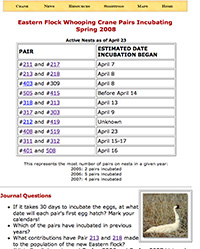| Dear
Journey North,
April
23 was a beautiful day and the perfect day for the nest survey
flight I had scheduled with Windway pilot Mike Frakes. The purpose
was to check on known nests that aren’t visible from the
ground as well as check on other pairs of birds suspected to
be nesting. When Richard Urbanek flew on 14 April he found and
confirmed 6 active nests on the Necedah NWR. Since then two other
pairs were suspected to have started nesting.
Signals Help
Even when the birds aren’t visible we learn a lot based
on the strength of the signal from their radio transmitter. If
a transmitter
is functioning normally, the signal is usually pretty strong. If
all of the sudden the signal is coming from the same area but is
sometimes weak we begin to suspect that the weak signal is due
to that bird sitting on a nest and incubating. In a sitting position
the antenna is covered and the range of the signal is reduced.
Nest Check: Four Known Plus Three New
We quickly checked the 4 nests on the southern half of the refuge
(211 and 217; 213 and 218; 313 and 318; and 309 and 403). We observed
one member of each pair sitting on the nest, incubating. After
checking those 4 nests, we headed north to check the pairs who
were suspected to be nesting. Our tracking team had done an excellent
job interpreting the behavior and the signals of the birds, as
we discovered both suspected pairs (11 & 12-03 and 1-04 & 8-05)
were indeed incubating! Within the first 45 minutes of our flight
we had seen 6 nests, 2 of which hadn’t been confirmed prior
to our seeing them. We checked the other pairs known to be nesting
on the north half of the refuge. Then tracked down our final pair,
408 and 519. They had been seen together on Tuesday afternoon (Apr.
22), which meant they weren’t on a nest — but when
we found them, one of them was incubating! It sometimes amazes
me how quickly these birds seem to go from appearing to do nothing
(in regards to reproductive behavior) to building a nest, laying
eggs, and beginning incubation. Our total was now 9 active nests.
Missing Pair Found! TEN Nests Now!
Our next task was to look for missing pair #212 and 419. The transmitters
on both these birds are non-functional so they can’t be tracked.
We
first searched their main use area on a state wildlife area north
of Necedah but found no Whooping Cranes. On the way
to the private property they use in the fall, I saw two white
birds on a large, remote marsh east of us. Pilot Mike turned the
plane and we went
for a closer look. We descended and circled over the birds; they
were Whooping Cranes — and a nest! I scanned through all
the radio signals and didn’t pick up a single beep. It had
to be our missing pair: 212 and 419. The count was now TEN nests.
An excellent
day!! (See
chart >>)
What’s Next?
So far the birds are doing great. We hope that will continue. Some
pairs (like #211 and 217) have already been incubating for over
two weeks. Others (like 408 and 519) just started yesterday.
That means more monitoring and keeping fingers crossed in hopes
that all these pairs will successfully hatch their
eggs! Stay tuned.
Sara Zimorski, Aviculturalist
|
April 23 Nest Survey
Click photos to enlarge.
Photos
Sara Zimorski

From
the air: nest of #212 and #409.

See the little box? It's the
nest of 408 and 519! This brand
new nest probably just began April 22. I’ve
drawn a square around the nest since it’s hard to pick
out otherwise.

This is #309's FIRST nest! Her new mate is $403.

|







